By Heather Mangal
The Bronx Journal Staff
The Clock Tower building on the corner of Lincoln Avenue and Bruckner Boulevard in the Bronx is a beautiful five-story testament to the changing fortunes of the borough. In the 1880’s, it was the Estey Piano factory, which reflected the industrial boom of the area. The thriving factory was abandoned many decades later, coinciding with the heroin epidemic in the area during the 70s and 80s. Today it is the home to artists lofts that rent from $1300 to $2475.
Like the tower, the South Bronx is undergoing a face lift. The Port Morris area of the South Bronx in the 1970’s and 80’s was filled with abandoned manufacturing facilities. Business picked up their factories, moving them first to the south and then to Asia, leaving behind facades of brick and empty corridors.
“In the late 1990’s and early 2000’s, when the artists in the Soho area noticed their areas had become gentrified, they started looking around for similar areas for reasonable rents and they found Mott Haven,” said Bronx historian, Lloyd Ultan.
Once a bustling piano hub, the Clock Tower building is now home to hundreds. The building is owned by the Brooklyn-based Carnegie Management Inc., the same company that owns the Bushwick Lofts in Brooklyn, which have amenities such as a pool, café and gym.
Gentrification has been snaking its way through most of New York City, but the South Bronx has been untouched for quite some time. This is changing. Whether or not you like it depends on whether you stand to benefit, financially or socially. Bronx business owners are hoping to see an uptick in sales, while some long-term residents are concerned about being priced out of the neighborhood.
While the South Bronx remains inhabited by multi-ethnic residents with lower incomes, people with higher incomes are starting to move in, say historian Ultan and Mark Naison, a Fordham University professor of African American Studies.
“A lot of times when neighborhoods start to get better, it’s better for everybody if you go to a school that’s diverse,” says Naison. “It’s better for kids who are working-class or poor if there are some middle-class families in the school.”
Naison, also known as Notorious Ph.D, got his nickname because he raps about gentrification and its negative effects on low-income neighborhoods. “The problem is, whenever that happens, the poor and working class people get kicked out and then they are going to go to a place where only poor people live.”
If history repeats itself, a community with multiple income levels, both high and low will not exist for long, says Naison. Sooner or later the residents who have much more money will replace the original low-income residents, says Naison, just as it happened in parts of Harlem, Rego Park, Williamsburg, Park Slope, and Bensonhurst.
The Bronx is 53.5 percent Hispanic, which is continuing to increasee, 30.1 percent black, 10.9 percent white, and 3.4 percent Asian, according to "Discovering The Bronx: Using Census Data to Highlight Social Problems and Achievements in a Major Urban Area" by William Bosworth. The census also states the population of New York County, Manhattan, is 48 percent white, 25.4 percent Latino, 15.6 percent black, and 11.3 percent Asian. Those who have high incomes live in Manhattan, while those with low incomes tend to live in the Bronx and parts of Brooklyn. From 2006-2008, Bronx County had the highest poverty rate in the northeast at 27.8 percent. The South Bronx, which is Congressional District 16, ranked first in the country for poverty.
“Ethnically it [the Bronx] was largely Puerto Rican in the 1970’s with some blacks,” says Ultan. “By the time you hit the 1990’s, the Puerto Ricans did what previous ethnic groups have done -- moved out to suburbs up and up the social ladder. In the late 1990’s, Mexicans started moving in. When there was no more space in Washington Heights, Dominicans moved in also.”
Those in the middle are continuously scanning the horizon for the next reasonable neighborhood to colonize, says Naison. “I notice them [the yuppies], but it doesn’t bother me,” says Desiree Taveras, 26, a lifelong South Bronx resident from the Mott Haven neighborhood. “The SoBro building is three blocks away from me. When I was little, I never saw white people in my neighborhood, but now they are moving in. It won’t bother me until the rent goes up.”

In addition to spanking new lofts, the crime rate has also dropped. In 2007, there were 19 drug related deaths and in 2010 there were only eight. The number of robberies went from 343 to 262 and major felony crimes went from 1,325 to 1,266.
Gentrification does have some pros for the neighborhood, says Naison. Police officers are more likely to protect communities once they are gentrified. Healthier food options become available and, of course, hip bars open up, he says.
Naison relates an incident in the past when he was hosting a tour in the South Bronx. One of the participants, a pregnant woman with diabetes, needed to eat, but the only options were unhealthy fast food.
“The terrible thing about gentrification are some of the things it brings are kind of fun. Bruckner Bar and Grill is a kind of cool spot,” says Naison.
Bruckner Bar and Grill is a young and fresh joint. There is a brunch menu that serves eggs Benedict and eggs Florentine with bloody Marys and mimosas. They serve lattes and tiramisu. The lunch and dinner menu consists of veggie burgers, Mediterranean platters, calamari salads and grilled Portobello sandwiches.

Bruckner Bar and Grill staff got defensive when it was suggested “yuppies” were moving in. “We get no suits here, mostly teachers and professional artists,” says Heather McTiernan, a server at the restaurant.
McTiernan says she chose to live in the South Bronx because it is cheap and not gentrified. She is protective of her low-income neighbors. “They were pushed out of Brooklyn and Harlem and now they are here and they are going to stay here,” said McTiernan. “I don’t think the South Bronx is ever going to change. That’s why I chose to live here and have been living here for five years.”
In addition to hot new bars, the South Bronx now has a brewery, The Bronx Brewery. Chris Gallant, 31, from Boston, Massachussetts, co-founded the brewery with two of his friends, one who is from Riverdale and wanted to start a business in his borough. The men decided the South Bronx was the best place to build their business.
“The best spot is a couple of things,” says Gallant, a MIT grad. “It’s a neighborhood that welcomes you. It’s where can you find enough space -- the South Bronx is awesome for that -- and where can you afford it. And the fourth thing, which is important for us, is somewhere that we can distribute from,” says Gallant. “And that’s part of the reason we are here is because it’s so easy to get to.”
From a new business owner’s perspective, Gallant states that gentrification does have its pros and cons.
“The good parts are it sort of gets cleaned up, it’s safer, more businesses move here,” says Gallant. “The bad part is rents go up and some people can’t afford to live here. It’s certainly something we are worried about as we grow. We need more space. We would love for this area to gentrify more, but we realize what the cost of that would be for us, for our business specifically, is increased rents, which could be a problem.”

Naison experienced this when Park Slope, Brooklyn gentrified. He was there at the beginning, much like Gallant is in the South Bronx. But Naison was a resident not a business owner. When Naison first moved to Park Slope, it was not a very homey neighborhood. He was involved with building a community sports program that brought everyone together. The community also built block associations, Parent Teachers Associations, and a food co-op. For the next 10 or 15 years, the community evolved and the quality of life improved for all. That changed, says Naison, when the rents went up due to gentrification.
The Huffington Post published an article about the 2010 Census data on America’s 10 most segregated cities. New York City was ranked number three. This is because of the lack of diversity in neighborhoods and a large gap between the rich and the poor. "The Persistence of Segregation in the Metropolis" by Brown University professor John Logan and Florida State University professor Brian Stults measured segregation using the Index of Dissimilarity. New York City has a dissimilarity index of 79.1 percent, which means that almost 80 percent of the population would have to change neighborhood in order for the city to reflect the overall racial makeup.
Diverse neighborhoods may be the best solution for everyone, says Naison, but neighborhoods generally do not stay diverse for long. He says that once they become diverse, they sooner or later become taken over by wealth.
“Gay people are pioneers in opening up new neighborhoods,” says Naison. “When you look at gentrification, you look at artists, gay people, and then interracial couples.”
The South Bronx started to change when the middle-class blacks and Latinos were priced out of Harlem, he says. There are certain demographics that begin building on low-income neighborhoods, explains Naison, this eventually leads to a complete gentrification of that area.
“You have people who don’t want to live in like a milquetoast kind of environment. They want to have something that’s edgy and new,” says Naison. “They also like the idea of lower rent. You move to the South Bronx and you are going to be paying a hell of a lot less than the Lower East Side or Williamsburg or Harlem.”
Naison adds that a middle ground between gentrified and poor neighborhoods, otherwise known as diverse neighborhoods, will not exist for longer than 10 years in this society because “money rules.”
Even the affordable housing “solution” is not really working out for the unemployed or for people making the low end of low-income, he says. “Some of the affordable housing being built in the South Bronx, you have to make $36,000 a year and the average family in the neighborhood makes $21,000,” says Naison.
Historian Lloyd Ultan believes that the high-rise, low-income housing projects will prevent a complete gentrification because people with a high income are prevented from moving in. “I don’t think the area would become completely gentrified,” said Ultan. “If the area becomes gentrified, it will be low-income and high-income people in the same area.” He says that this will be the best thing for the South Bronx.
“The government tends to listen to people who are wealthy,” Ultan says, which means fewer broken streetlights, pot holes, and spikes in crime. It could be a win-win for everyone.
Gallant said that the Bronx Brewery is going to give money back to the South Bronx community, provide jobs for people in the Bronx and buy local ingredients for their brews.
“When we open our tap room eventually, the more gentrified the area is, the more people that live here, the more people will come,” says Gallant.







